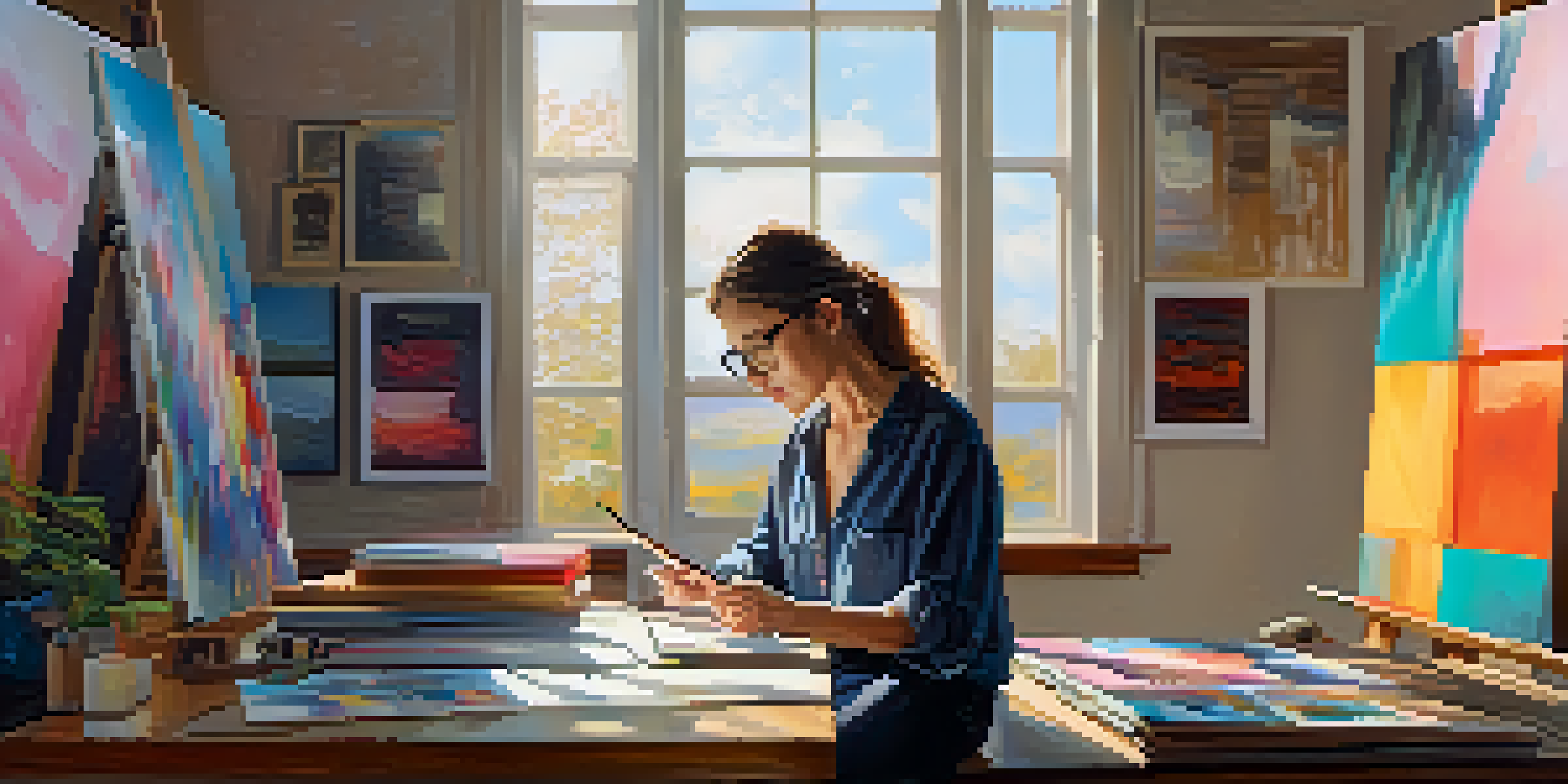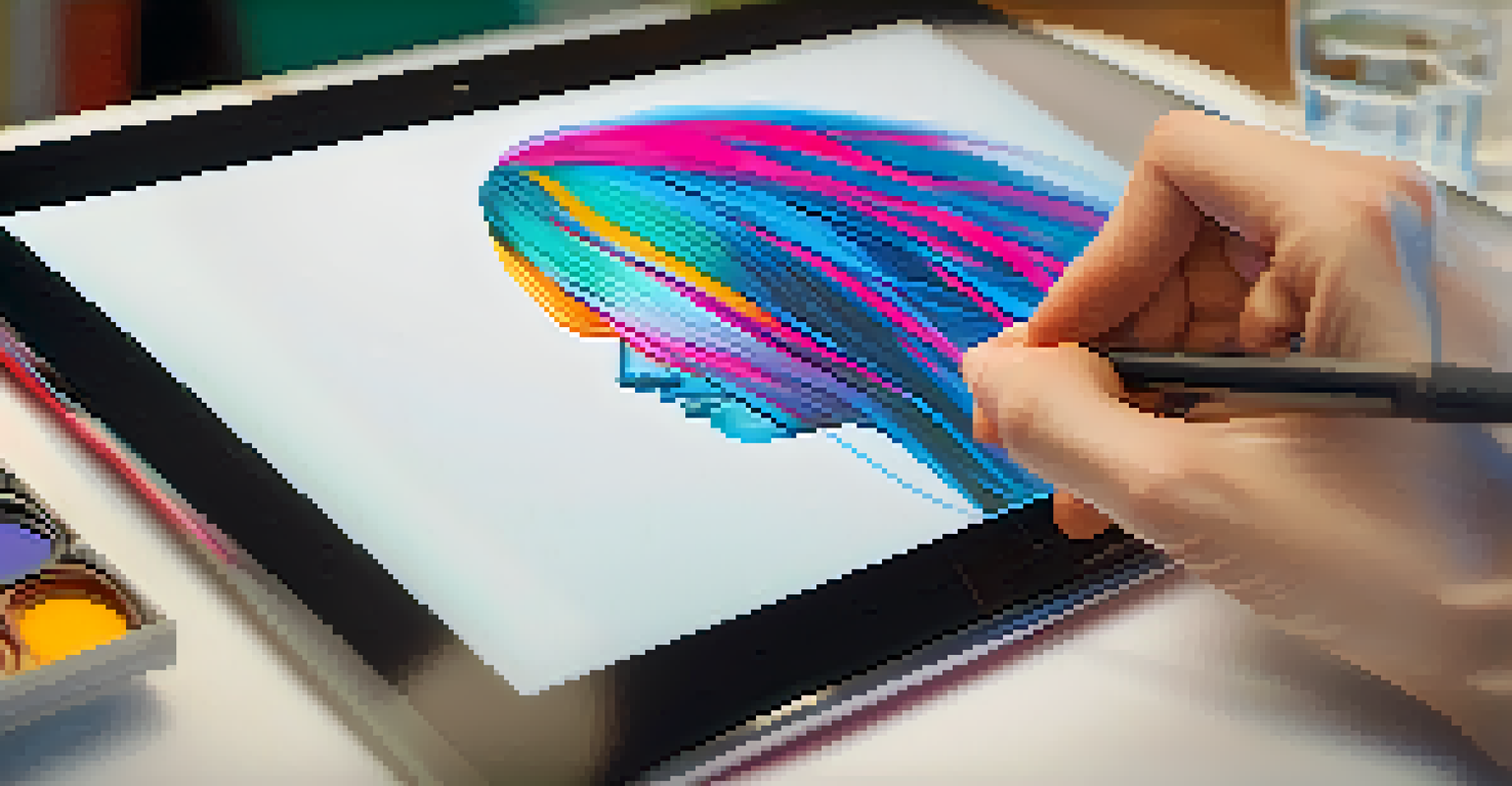The Evolution of Digital Painting: From Canvas to Screen

The Origins of Digital Painting: A New Frontier
Digital painting began as a nascent idea in the late 20th century, coinciding with the rise of personal computers. Artists started experimenting with software like Adobe Photoshop, which offered new tools and capabilities that traditional painting could not. This marked a significant shift, allowing artists to blend traditional techniques with digital innovation.
Digital painting is not just a new medium; it’s a new way of thinking about art and creativity.
Imagine standing in a gallery filled with oil paintings, only to find a vibrant digital canvas that seems to pulse with energy. This new medium opened doors to creativity, where artists could easily undo mistakes and explore endless color palettes. The transition from canvas to screen was not just about changing materials; it was about redefining the artistic process itself.
As digital technology advanced, so did the tools available to artists. Tablets and styluses emerged, mimicking the experience of painting on canvas while offering the convenience of digital editing. This evolution allowed digital painting to flourish, attracting both traditional artists and newcomers eager to explore this exciting medium.
Tools that Revolutionized Digital Art Creation
The journey of digital painting is closely tied to the development of specific tools and software. Programs like Corel Painter and ArtRage were designed to simulate traditional painting techniques, giving artists a familiar feel while working in a digital environment. These advancements made it easier for artists to transition their skills to the screen.

In addition to software, hardware has played a crucial role in this evolution. Graphics tablets, such as those from Wacom, enabled artists to draw directly onto a screen, translating their movements into digital strokes. This level of interactivity bridged the gap between traditional methods and digital innovation, bringing a tactile sensation back into the digital realm.
Digital Painting's Creative Revolution
Digital painting merges traditional techniques with innovative tools, allowing artists to explore new creative possibilities.
Furthermore, the introduction of artificial intelligence and machine learning in art tools has opened up new creative possibilities. Artists can now experiment with intelligent brushes that adapt to their style, enhancing creativity while streamlining the process. As these tools continue to evolve, they promise to redefine what digital painting can achieve.
Digital Painting Styles: A Blend of Tradition and Innovation
Digital painting encompasses a wide array of styles that reflect both traditional techniques and modern aesthetics. From hyper-realistic portraits to abstract compositions, artists can explore diverse expressions without the constraints of physical materials. This versatility allows for a unique blend of creativity that can resonate with a broader audience.
The great thing about digital art is that it allows for endless exploration and experimentation.
Consider the way digital artists can mimic the fluidity of watercolors or the texture of oil paints, all while harnessing the limitless potential of digital mediums. Techniques like layering and blending can be applied effortlessly, resulting in stunning visuals that captivate viewers. This ability to experiment and adapt has made digital painting an appealing choice for many artists.
Moreover, the rise of social media has fostered a community where digital artists can share their work and receive instant feedback. Platforms like Instagram and DeviantArt serve as vibrant galleries that showcase diverse digital styles, from whimsical illustrations to gripping concept art. This interconnectedness not only promotes artistic growth but also inspires collaboration across various disciplines.
The Role of Community in Digital Painting
One of the most compelling aspects of digital painting is the strong sense of community it fosters among artists. Online forums, social media groups, and platforms like Behance allow artists to connect, share techniques, and collaborate on projects. This supportive environment encourages growth and experimentation, making art more accessible to everyone.
Imagine joining a virtual art class where you can learn alongside artists from around the globe, exchanging ideas and tips in real-time. This sense of camaraderie enriches the artistic journey, allowing individuals to draw inspiration from diverse cultures and perspectives. Community-driven events, such as challenges and competitions, further enhance the experience, pushing artists to innovate.
Community Drives Artistic Growth
The digital art community fosters collaboration and mentorship, enriching the experience for both new and experienced artists.
In addition, mentorship opportunities abound within this community. Experienced artists often share their knowledge through tutorials and live streams, empowering newcomers to hone their skills. As a result, digital painting thrives not just as a solitary practice but as a collaborative effort that brings artists together.
The Impact of Technology on Digital Artistry
Technology has fundamentally changed the landscape of digital painting, making it more accessible than ever. With powerful software and affordable hardware available, aspiring artists can create stunning works from the comfort of their homes. This democratization of art has led to an explosion of creativity, with new voices emerging in the digital space.
Consider the shift from expensive studio setups to mobile applications that allow artists to paint on their tablets or phones. This mobility has transformed how and where art can be created, with artists capturing inspiration on the go. The ability to share work instantly on platforms like Twitter and Instagram further amplifies this reach, allowing for immediate interaction with audiences.
Moreover, advancements in virtual reality (VR) and augmented reality (AR) are pushing the boundaries of digital painting. Artists can now create immersive experiences that engage viewers in entirely new ways. As technology continues to evolve, so too does the potential for digital painting to transform traditional artistic expression.
Challenges and Criticisms of Digital Painting
Despite its many advantages, digital painting also faces challenges and criticisms. Some traditionalists argue that digital art lacks the authenticity and emotional depth of traditional media. They believe that the tactile experience of brush on canvas cannot be replicated with pixels, which can lead to a divide between digital and traditional artists.
Additionally, the ease of editing in digital painting can lead to a reliance on shortcuts, potentially stunting an artist's growth. With the ability to undo mistakes and apply filters, some artists may miss out on the learning experiences that come from traditional methods. Striking a balance between the convenience of digital tools and the discipline of traditional techniques is essential for artistic development.
Technology Shapes Art's Future
Advancements in technology, including AI and VR, are expanding the boundaries of digital painting and redefining artistic expression.
Lastly, the saturation of digital art in online spaces can make it challenging for individual artists to stand out. With countless creators sharing their work, finding a unique voice can feel daunting. Nonetheless, overcoming these challenges often leads to greater innovation and creativity, pushing artists to refine their skills and express their individuality.
The Future of Digital Painting: Infinite Possibilities
As we look to the future, the possibilities for digital painting seem endless. With ongoing advancements in technology, artists can explore new techniques and mediums that were previously unimaginable. From AI-assisted design to virtual reality environments, the next generation of digital painters will have tools that enhance creativity like never before.
Imagine a world where artists can create immersive installations that blend physical and digital elements, engaging audiences in groundbreaking ways. The fusion of art and technology will continue to inspire innovative approaches to storytelling and visual expression. As digital painting evolves, it will undoubtedly influence other art forms and cross-disciplinary collaborations.

Moreover, as more artists embrace digital painting, we can expect to see a rich tapestry of styles and narratives emerging. This evolution will reflect the diverse experiences and backgrounds of artists around the world, enriching the global art community. The future of digital painting is not just about technology; it’s about celebrating creativity in all its forms.